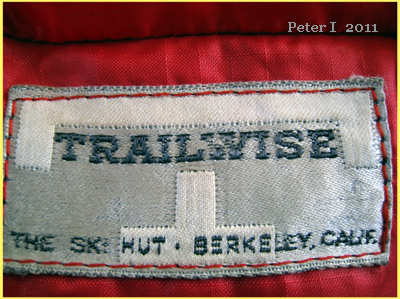 earliest
Trailwise label
earliest
Trailwise label earliest
Trailwise label
earliest
Trailwise labelBegun even earlier than
GERRY in Colorado, George Rudolf's "The
Ski Hut" was probably the single strongest influence and
source for modern, lightweight backpacking and climbing gear during
the 1950s and 1960s for persons on the West Coast...The Ski Hut
was formed in 1935 in Berkeley, CA by Mr. Rudolf 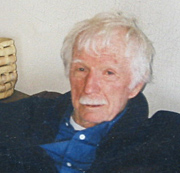 and
a partner Phillip Von Lublein. World War II closed up the shop
until 1946, the same year that GERRY moved itself to its permanent
home in Ward, Colorado.....During Ski Hut's early years, it was
not so much a gear-making innovator company as it was an importer
and supplier of the things that climbers, skiers and backpackers
needed. But this changed sometime in the early 1950s (probably
1951), when Mr. Rudolph created "TRAILWISE," and thus
began the period of Rudolf's company creating its own designs
and products. In the late 1950s, Mr. Rudolf formed "Donner
Mountain Company" (DMC), which was mainly an importer, and
which was responsible for the late 1960s craze about Pivetta boots
from Italy (I owned two pairs and was wild about them!)....Over the course
of its history, the original The Ski Hut store became one facet
of a larger holding which included the Trailwise manufacturing,
DMC, and a thriving Mail Order component..
and
a partner Phillip Von Lublein. World War II closed up the shop
until 1946, the same year that GERRY moved itself to its permanent
home in Ward, Colorado.....During Ski Hut's early years, it was
not so much a gear-making innovator company as it was an importer
and supplier of the things that climbers, skiers and backpackers
needed. But this changed sometime in the early 1950s (probably
1951), when Mr. Rudolph created "TRAILWISE," and thus
began the period of Rudolf's company creating its own designs
and products. In the late 1950s, Mr. Rudolf formed "Donner
Mountain Company" (DMC), which was mainly an importer, and
which was responsible for the late 1960s craze about Pivetta boots
from Italy (I owned two pairs and was wild about them!)....Over the course
of its history, the original The Ski Hut store became one facet
of a larger holding which included the Trailwise manufacturing,
DMC, and a thriving Mail Order component..
Ski Hut/Trailwise dominated the West Coast during that distant era before the birth of the twin Bay Area giants, The North Face and Sierra Designs. George Marks, one of the co-founders of Sierra Designs, writes, "...that is after all where Bob (Swanson) and I met and where we got our start in the outdoor industry. Hap Klopp (North Face), too, among others." After Trailwise's Justus Bauschinger left, designer Mark Erickson took over. Meanwhile, Justus went on to found Class Five....Peter Noone was also a long-time Manager at the Ski Hut store during the 1960s, and into the 1970s, he told me that he was "General Manager of The Ski Hut for 16 years." He was also involved with Trailwise and Donner Mountain Company.......
George Rudolf was affectionately known as "The Grey Ghost" and was a neighbor to George Marks in Point Richmond, California until he passed away just a few days shy of 90 on May 31, 1998. (information from George Marks interview and other ex-employees). Image of Mr. Rudolf is compliments of Mr. Marks and shows Mr. Rudolf in late life.
HONORS:
Mr. Rudolf (and Allen
Steck) were given stellar honors in 1992 as among the gear industry's
twelve "greatest pioneers" - see more here
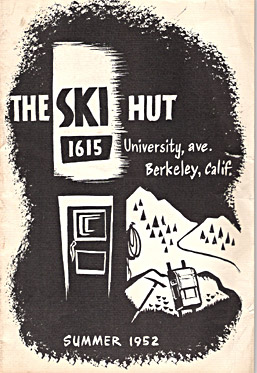 .
Mr.
Duncan Dwelle was
influential in the early history of Trailwise... Upon seeing my
pictures of Mr. Rudolf, he wrote, "Seeing George Rudolph
reminds me that I may not have mentioned I succeeded Al Steck
as general manager of Trailwise in 1968 when he left to found
Mountain Travel with Leo le Bon."..... Later, I will write
more about Mr. Dwelle's many contributions (he was also important
in the start-ups of both North Face and Sierra Designs). Note--
Mr. Rudolf's name is often misspelled "Rudolph" in many
sources that I have seen). Mr. George A. Rudolf, the founder of
The Ski Hut, was born June 5, 1908 and received his Social Security
card in California.
.
Mr.
Duncan Dwelle was
influential in the early history of Trailwise... Upon seeing my
pictures of Mr. Rudolf, he wrote, "Seeing George Rudolph
reminds me that I may not have mentioned I succeeded Al Steck
as general manager of Trailwise in 1968 when he left to found
Mountain Travel with Leo le Bon."..... Later, I will write
more about Mr. Dwelle's many contributions (he was also important
in the start-ups of both North Face and Sierra Designs). Note--
Mr. Rudolf's name is often misspelled "Rudolph" in many
sources that I have seen). Mr. George A. Rudolf, the founder of
The Ski Hut, was born June 5, 1908 and received his Social Security
card in California.
One key reason for the popularity and high quality of the Trailwise/Ski Hut products is explained by a former employee this way: "Part of the Trailwise design features were based upon real experience in the field, often during very extreme conditions. Ski Hut also had many customers (e.g., Colin Fletcher) who often made useful design recommendations. Boxes were also kept of products that had defects or had failed and were returned by buyers. Ski Hut typically made good on these items by refunding the money or providing a replacement. Much of this stuff was subsequently sent to Trailwise who monitored the products and often made improvements to the product or in the quality control."
Please Note: All Material on this page, and in all my "History of Gear" webpages, is copyrighted, and no usage of my material is permitted unless explicit permission is granted by me, Bruce B. Johnson, owner of OregonPhotos.com. Contact: jupiterman47@gmail.com ---A major contributor on this page is George Marks of Sierra Designs...Your contributions are welcome if you have material about The Ski Hut and its products, or about other vintage gear manufacturers! Email me!
Colin Fletcher, whom many regard as the Father of modern backpacking due to his many influential books about the subject, did much to publicize Trailwise gear. Click here for my page about this famous person in the History of Gear.
One of The Ski Hut's
signature products was their trend-setting "Slimline"
sleeping bag (above), designed by well-known climber Allen Steck,
sometime in the early 1960s..(Steck also had some share in Trailwise)..
Originally designed with no zipper at all to save weight, it didn't
sell well enough that way, so a full zipper was introduced later
in the 1960s.).... 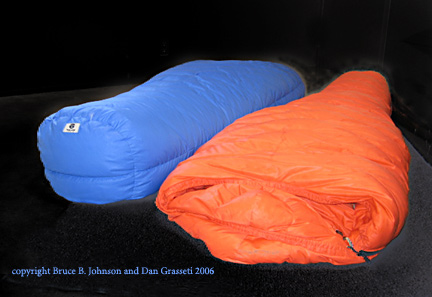 Many
proud owners of Slimline bags have contacted me about how well
this very lightweight bag has worked for them. In the image, the
orange Slimline and blue Chevron bags still have impressive lofts,
despite dating from the early 1970s (the filling is high quality
white goose down)..... Prior to about 1969, a gorgeous ruby red
shell was offered on the Slimline (see label picture at page top).....For
winter, Trailwise made the Chevron, a serious winter bag. So the
Slimline was the lightest; while a model named the Norrland (not
shown) was a wider cut bag rated to zero degrees (a popular warmth
category of the time). Click
here for notes from
a sleeping bag salesman of that time.
Many
proud owners of Slimline bags have contacted me about how well
this very lightweight bag has worked for them. In the image, the
orange Slimline and blue Chevron bags still have impressive lofts,
despite dating from the early 1970s (the filling is high quality
white goose down)..... Prior to about 1969, a gorgeous ruby red
shell was offered on the Slimline (see label picture at page top).....For
winter, Trailwise made the Chevron, a serious winter bag. So the
Slimline was the lightest; while a model named the Norrland (not
shown) was a wider cut bag rated to zero degrees (a popular warmth
category of the time). Click
here for notes from
a sleeping bag salesman of that time.
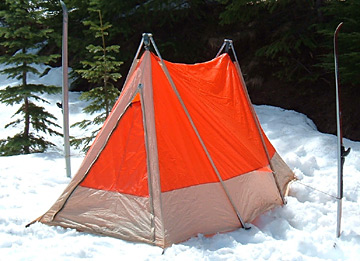 The Trailwise "Fitzroy"
tent* illustrates the company's willingness to experiment with
new design concepts. It was designed by Phil Scott, one of the
company's key designers. The "Fitz" was created as a
strong 4-season mountaineering tent, and a key feature (shown
in pic) was its canted poles (cantilever poles), allowing it to
eliminate the bothersome front and rear guy lines. It also featured
an optional ridgepole, makes it stronger and more self-supporting....This
tent was rather higher and roomier than many of theA-frames of
its era. True, its basic design is still that of an A-frame. To
see an even more radically-conceived A-frame design that also
eliminated the front/rear guylines, visit my page about the Rivendell
Bombshelter (which also used a ridgepole).
The Trailwise "Fitzroy"
tent* illustrates the company's willingness to experiment with
new design concepts. It was designed by Phil Scott, one of the
company's key designers. The "Fitz" was created as a
strong 4-season mountaineering tent, and a key feature (shown
in pic) was its canted poles (cantilever poles), allowing it to
eliminate the bothersome front and rear guy lines. It also featured
an optional ridgepole, makes it stronger and more self-supporting....This
tent was rather higher and roomier than many of theA-frames of
its era. True, its basic design is still that of an A-frame. To
see an even more radically-conceived A-frame design that also
eliminated the front/rear guylines, visit my page about the Rivendell
Bombshelter (which also used a ridgepole).
The Fitzroy was neither a geodesic design, nor a design like Jack Stephenson's Elliptical Arc design
My best information about the status of Ski Hut/Trailwise is that the company and brand are both defunct for some 20 years or more, although many used Trailwise items can be found on eBay.......One well-placed former employee stated, "...when Ski Hut and Trailwise were sold in the 1970s, it is true that Saska acquired them. Trailwise was later purchased by the glove company based in Chicago. However, I'm not sure that they acquired the Ski Hut. Here, my knowledge of the situation is very cloudy. I do know that the Ski Hut was subsequently owned by Copeland Sports before the Ski Hut finally ended (along with Copeland Sports some years later).".... Another ex-manager at Trailwise reported to me that Mr. Rudolf sold Trailwise/Ski Hut to Saska Skiwear, which later sold it to the Boss Glove company in about 1978. Sales reached $2,5000,000 in 1979, the company was booming, and outfitted the first Women's expedition to climb Annapurna.....
Another reader recently
sent me a 1982 Trailwise catalog, with prices stratospherically
higher than just a couple years before; by this time, Trailwise
was under new ownership (probably Boss Glove) and was now based
in the Upper Midwest! One must imagine that with so many of their
classic tents and bags becoming so over-priced relative to their
competition, that Trailwise's new owner dropped such products
due to poor sales....In any case, in the early 80s, Trailwise's
product line became less and less tents and sleeping bags, and
more and more apparel, reflecting major changes in the philosophy
of the old company vs. the new one, and finally Trailwise was
dropped for good (incidentally, the Boss Glove Company is still
alive and well)......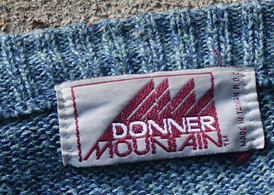
The man who started it all, George Rudolf, retired to Point Richmond, California... Mr. Rudolf was also apparently the owner of Donner Mountain Corporation (DMC), which reportedly shut down in the late 1970s, and he was also an investor in the Walrus Tent company founded by Bob Swanson and George Marks in 1984.(George Marks interview)
A History of Gear Requiem: The Ski Hut/Trailwise, operating 1935-1978 under original founder George Rudolf, with the company coming to a somewhat confusing end in the early 1980s under new owners (as documented above).
Please Note: All Material on this page, and in all my "History of Gear" webpages, is copyrighted, and no usage of my material is permitted unless explicit permission is granted by me, Bruce B. Johnson, owner of OregonPhotos.com
Get an authentic Jensen Pack!
Eric Hardee, a vintage gear lover near Seattle, WA has legal use (via Don Wittenberger) of the authentic Rivendell pack blueprints and patterns, and has been sewing/selling custom Jensen/Rivendell packs via word of mouth advertising for many years. Eric can sew up an original Jensen or Giant Jensen for you--- Contact him! He is a true lover of this pack. His email is ewak3@juno.com. Tell him that you heard about his packs from Bruce at OregonPhotos.com
Notes: The name "Fitzroy" has interesting derivations. As a name for a climber's tent, I am sure that Fitzroy was chosen due to its association with a famed rock tooth of a peak that rises out of the Patagonia Ice Fields in the southern tip of South America. But what is not so commonly known is that this peak was named after Robert Fitzroy, the Captain of the HMS Beagle, Charles Darwin's ship. Capt. Fitzroy rounded the tip of South America at Cape Horn in 1830, and while in the area, took aboard 4 "Indians," which he took to England to "civilize." One died of smallpox in England, and Fitzroy became so guilty he talked the Admiralty into footing another mapping expedition, this one with a personal goal of returning the remaining 3 Indians to their homeland! For extra company and justification on this second voyage, Capt. Fitzroy took aboard Darwin, an untried young naturalist who was to change how we view the Natural World.
Notes from Paul H., who sold quality backpacking gear in NYC in the early 70s: "...the Trailwise Norrland was the 0 degree semi-mummy that Trailwise offered. It's competition was, as I stated in another email, the H'br (Holubar) Timberline, the sd (Sierra Designs) 200, tnf (The North Face) Chamois, and the Class 5 class 2. .This 0 degree class was by far the most popular type of bag at that time, and all were priced about the same and had similar dimensions etc. I remember in the summer of '73 Backpacker Magazine came out with an article comparing all these bags in this class, using about every criteria one could think of; some of those early issues are of course a true wealth of technical and commercial info. Anyway I remember the article placed the Holubar Timberline just like one point or whatever above the Trailwise Norrland for the #1 spot. I remember thinking they had it all just right, too." Paul remembers, " I worked at Paragon Sporting Goods in NYC in the summer of 73, and then worked for Kreeger and Son for a year or so after that. As I said earlier, I saw a lot of different equipment come on and off the shelves."